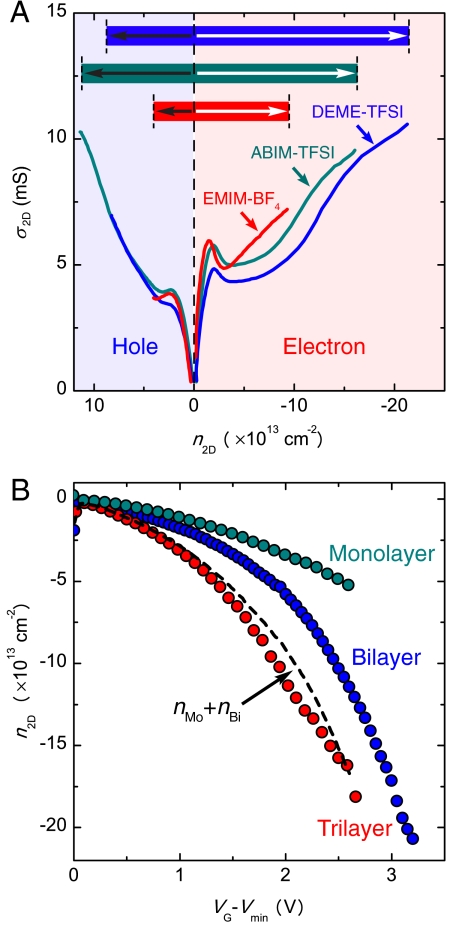Fig. 3.
Comparison of different ionic liquids. (A) The conductivity σ2D of bilayer graphene devices fabricated using three different ionic liquids (green, ABIM-TFSI; blue, DEME-TFSI; red, EMIM-BF4) as a function of carrier density n2D (measured from the Hall effect). It is apparent that all the main features observed in the conductivity (linear increase at low n2D, nonmonotonic behavior at intermediate n2D, and increase at a very large n2D) are essentially identical, irrespective of the specific ionic liquid used. This observation indicates that these features are intrinsic properties of bilayer graphene, not influenced by the specific ionic liquid used. Similar experiments were performed on mono- and trilayer and showed a similar insensitivity to the ionic liquid. Note also that, when plotted as a function of n2D, the asymmetry between electron and hole side in the conductivity appears to be much smaller than in the plots as a function of gate voltage (see Fig. 2). This result is indeed what should be expected if the asymmetry originates from the geometrical capacitance of the EDL that is different for the two different polarities (owing to the different physical size of positive and negative ions). The inset illustrates the maximum value of n2D for electrons (white arrows) and for holes (black arrows) accessible by means of the different ionic liquids. The largest carrier density that has been accessed in this study is 2 × 1014 cm-2 using DEME-TFSI. (B) The dependence of carrier density n2D on gate voltage VG (measured from the charge neutrality point) for mono-, bi-, and trilayer graphene devices, using DEME-TSFI as ionic liquid. The dashed black line is the sum of n2D of mono- and bilayer graphene, which compares well to the n2D measured in the trilayer. This relationship is approximately expected from the known band structure of these materials, because the two lowest energy bands of trilayer roughly correspond to the lowest energy band of mono- and bilayer.

